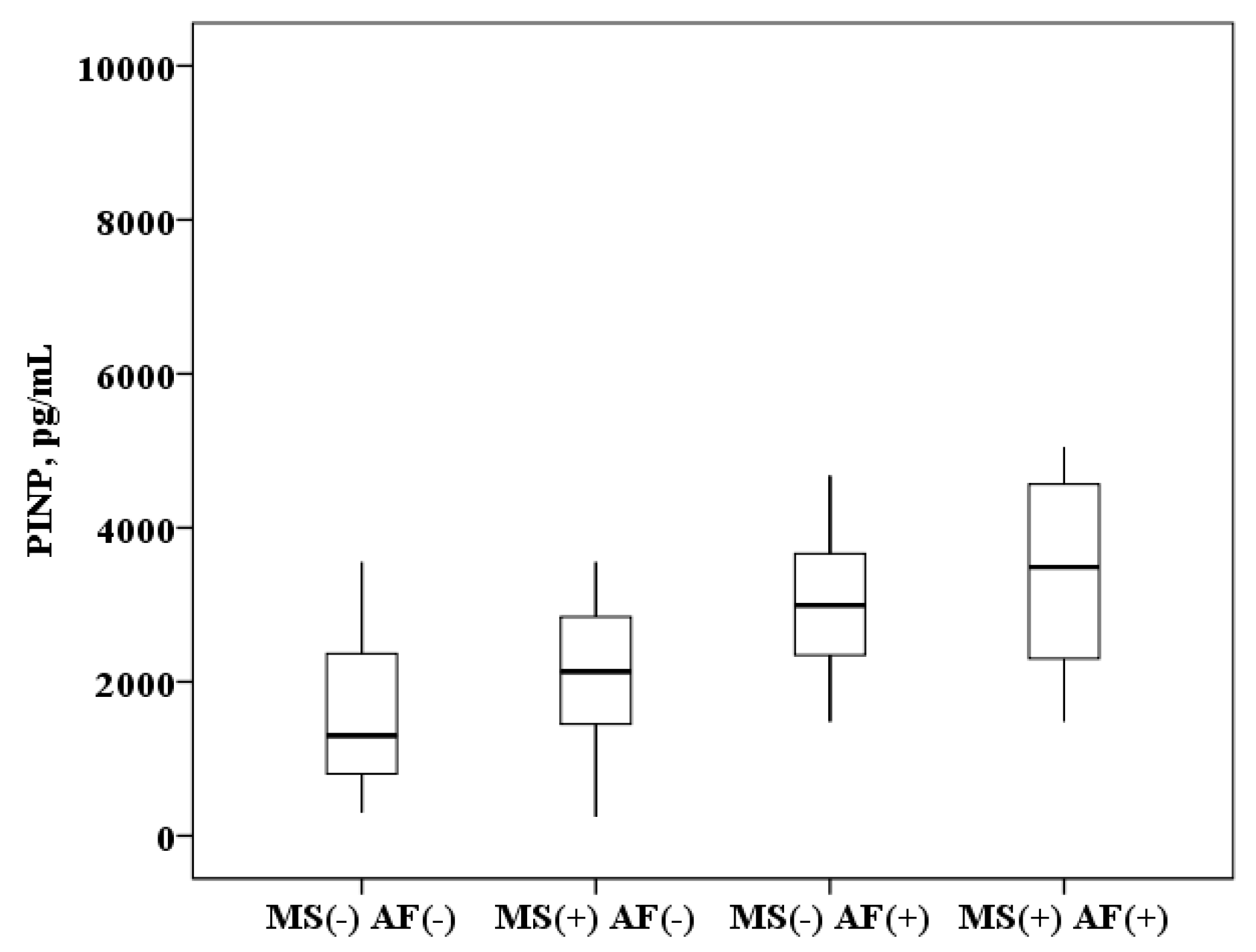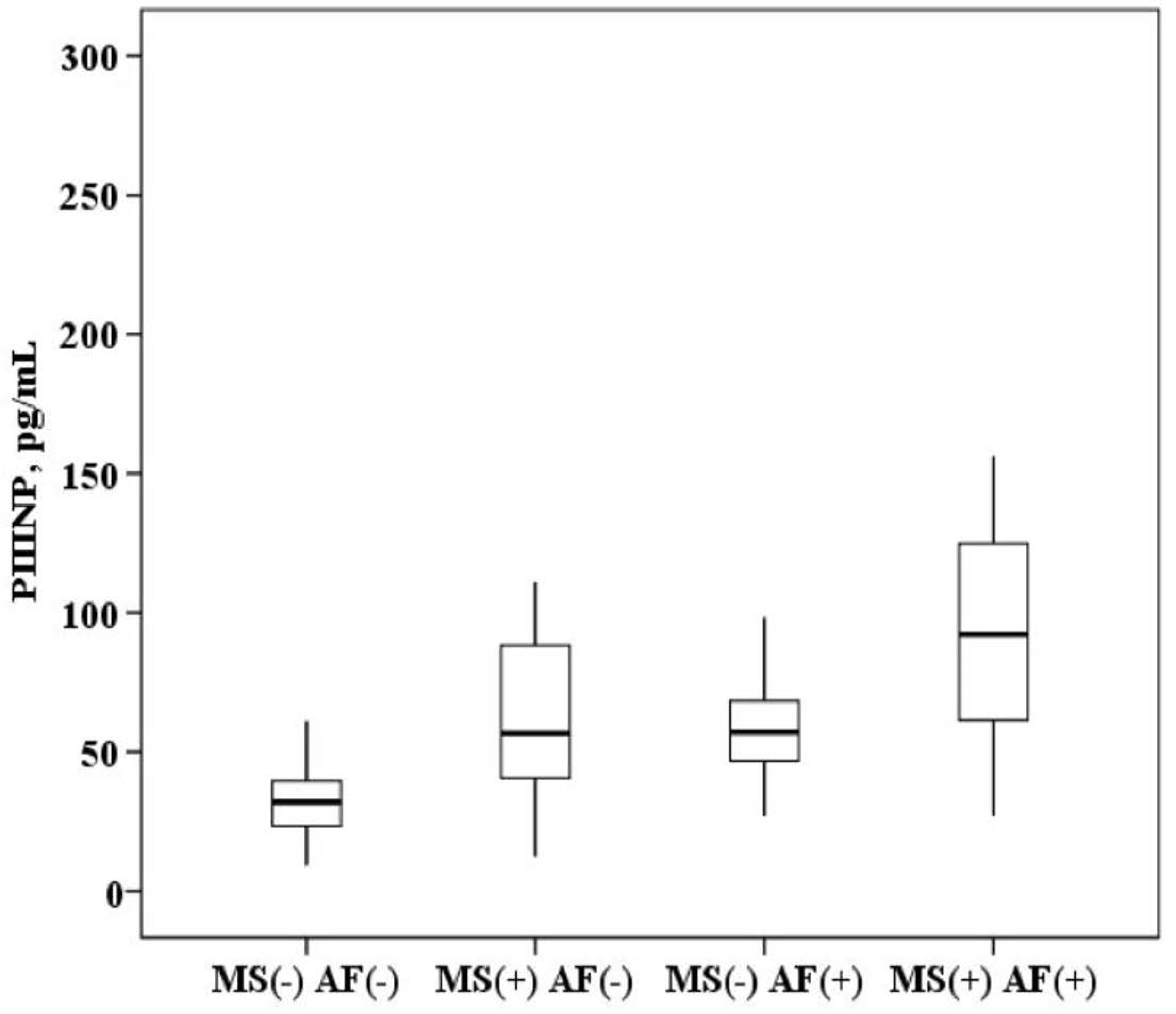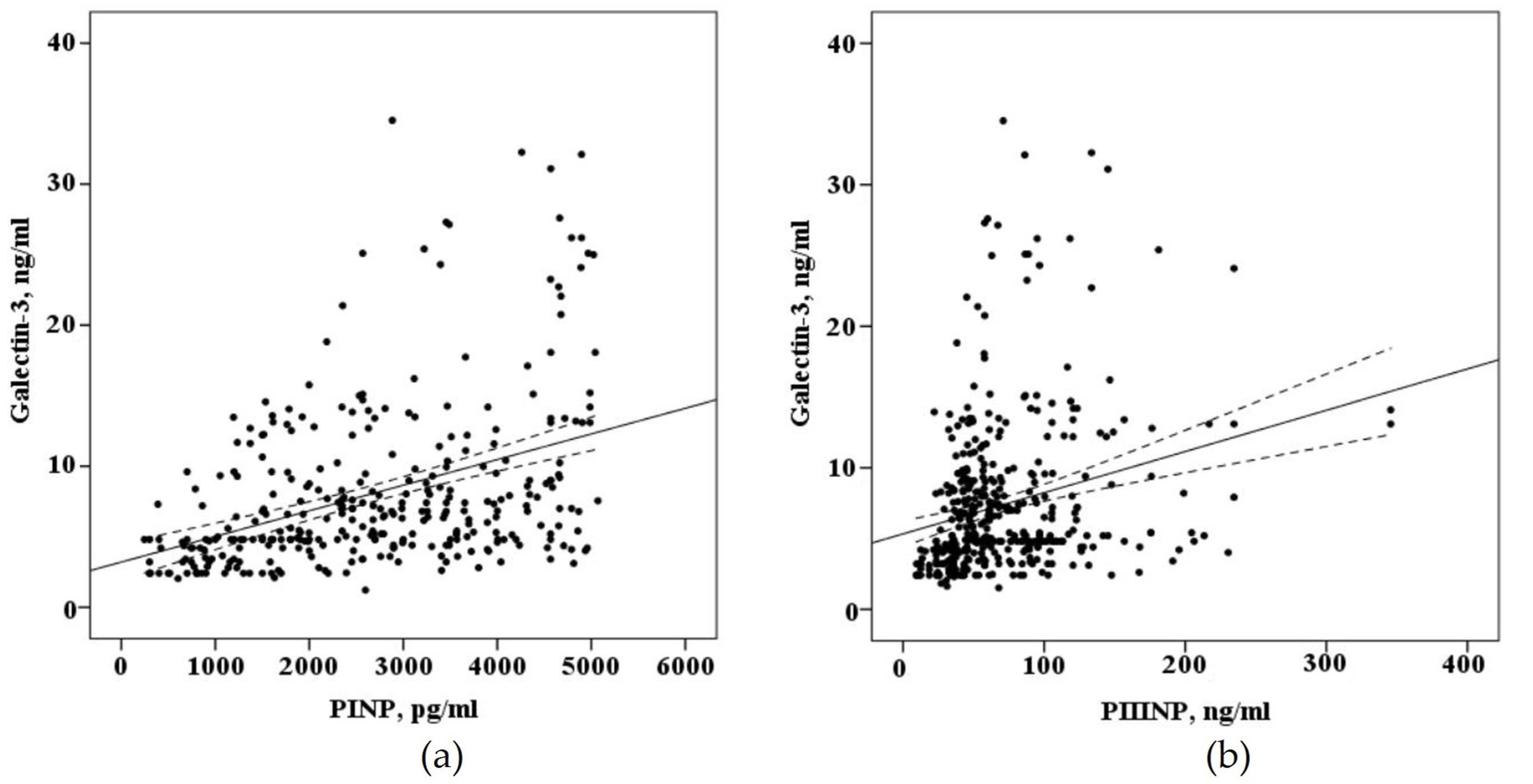Galectin-3, N-terminal Propeptides of Type I and III Procollagen in Patients with Atrial Fibrillation and Metabolic Syndrome
Abstract
1. Introduction
2. Results
3. Discussion
4. Materials and Methods
5. Conclusions
- 1.
- Galectin-3, PINP and PIIINP concentrations are higher in patients with AF and MS than in patients with AF without MS and MS without this arrhythmia.
- 2.
- Galectin-3 serum concentration positively correlates with parameters characterizing obesity and dilatation of the atria.
- 3.
- The severity of left atrial myocardial fibrosis is associated with an increase in the concentration of galectin-3, PINP and PIIINP.
- 4.
- An increase in serum galectin-3, PINP, PIIINP concentration can increase the risk of AF in patients with MS.
Limitations
Author Contributions
Funding
Conflicts of Interest
Abbreviations
| ACEi | angiotensin-converting enzyme inhibitors |
| AF | atrial fibrillation |
| ARBs | angiotensin II receptor blockers |
| ARIC | Atherosclerosis Risk in Communities study |
| AUC | area under curve |
| BMI | body mass index |
| CI | confidence interval |
| EF | left ventricular ejection fraction |
| HDL | high-density lipoproteins |
| IDF | International Diabetes Federation |
| LDL | low-density lipoproteins |
| MRI | magnetic resonance imaging |
| MS | metabolic syndrome |
| OR | odds ratio |
| PINP | N-terminal propeptide of procollagen I type |
| PIIINP | N-terminal propeptide of procollagen III type |
| ROC | receiver operating characteristic |
References
- Chugh, S.S.; Havmoeller, R.; Narayanan, K.; Singh, D.; Rienstra, M.; Benjamin, E.J.; Gillum, R.F.; Kim, Y.H.; McAnulty, J.H.; Zheng, Z.J.; et al. Worldwide epidemiology of atrial fibrillation: A global burden of disease 2010 study. Circulation 2014, 129, 837–847. [Google Scholar] [CrossRef] [PubMed]
- Staerk, L.; Sherer, J.A.; Ko, D.; Benjamin, E.J.; Helm, R.H. Atrial Fibrillation: Epidemiology, Pathophysiology, and Clinical Outcomes. Circ. Res. 2017, 120, 1501–1517. [Google Scholar] [CrossRef] [PubMed]
- Kim, Y.G.; Han, K.d.; Choi, J.I.; Boo, K.Y.; Kim, D.Y.; Oh, S.K.; Lee, K.N.; Shim, J.; Kim, J.S.; Kim, Y.H. Impact of the duration and degree of hypertension and body weight on new-onset atrial fibrillation: A nationwide population-based study. Hypertension 2019, 74, E45–E51. [Google Scholar] [CrossRef] [PubMed]
- Chamberlain, A.M.; Agarwal, S.K.; Ambrose, M.; Folsom, A.R.; Soliman, E.Z.; Alonso, A. Metabolic syndrome and incidence of atrial fibrillation among blacks and whites in the Atherosclerosis Risk in Communities (ARIC) Study. Am. Heart J. 2010, 159, 850–856. [Google Scholar] [CrossRef]
- Tsang, T.S.M.; Barnes, M.E.; Bailey, K.R.; Leibson, C.L.; Montgomery, S.C.; Takemoto, Y.; Diamond, P.M.; Marra, M.A.; Gersh, B.J.; Wiebers, D.O.; et al. Left atrial volume: Important risk marker of incident atrial fibrillation in 1655 older men and women. Mayo Clin. Proc. 2001, 76, 467–475. [Google Scholar] [CrossRef]
- Corradi, D. Atrial fibrillation from the pathologist’s perspective. Cardiovasc. Pathol. 2014, 23, 71–84. [Google Scholar] [CrossRef]
- Akoum, N.; Morris, A.; Perry, D.; Cates, J.; Burgon, N.; Kholmovski, E.; Macleod, R.; Marrouche, N. Substrate modification is a better predictor of catheter ablation success in atrial fibrillation than pulmonary vein isolation: An LGE-MRI study. Clin. Med. Insights Cardiol. 2015, 9, 25–31. [Google Scholar] [CrossRef]
- Mahajan, R.; Lau, D.H.; Brooks, A.G.; Shipp, N.J.; Manavis, J.; Wood, J.P.M.; Finnie, J.W.; Samuel, C.S.; Royce, S.G.; Twomey, D.J.; et al. Electrophysiological, Electroanatomical, and Structural Remodeling of the Atria as Consequences of Sustained Obesity. J. Am. Coll. Cardiol. 2015, 66, 1–11. [Google Scholar] [CrossRef]
- Sharma, U.C.; Pokharel, S.; van Brakel, T.J.; van Berlo, J.H.; Cleutjens, J.P.M.; Schroen, B.; André, S.; Crijns, H.J.G.M.; Gabius, H.J.; Maessen, J.; et al. Galectin-3 marks activated macrophages in failure-prone hypertrophied hearts and contributes to cardiac dysfunction. Circulation 2004, 110, 3121–3128. [Google Scholar] [CrossRef]
- Yu, L.; Ruifrok, W.P.T.; Meissner, M.; Bos, E.M.; van Goor, H.; Sanjabi, B.; van der Harst, P.; Pitt, B.; Goldstein, I.J.; Koerts, J.A.; et al. Genetic and pharmacological inhibition of galectin-3 prevents cardiac remodeling by interfering with myocardial fibrogenesis. Circ. Heart Fail. 2013, 6, 107–117. [Google Scholar] [CrossRef]
- Filipe, M.D.; Meijers, W.C.; van der Velde, A.R.; de Boer, R.A. Galectin-3 and heart failure: Prognosis, prediction & clinical utility. Clin. Chim. Acta 2015, 443, 48–56. [Google Scholar] [CrossRef] [PubMed]
- Ho, J.E.; Yin, X.; Levy, D.; Vasan, R.S.; Magnani, J.W.; Ellinor, P.T.; McManus, D.D.; Lubitz, S.A.; Larson, M.G.; Benjamin, E.J. Galectin 3 and incident atrial fibrillation in the community. Am. Heart J. 2014, 167, 729. [Google Scholar] [CrossRef] [PubMed]
- Timonen, P.; Magga, J.; Risteli, J.; Punnonen, K.; Vanninen, E.; Turpeinen, A.; Tuomainen, P.; Kuusisto, J.; Vuolteenaho, O.; Peuhkurinen, K. Cytokines, interstitial collagen and ventricular remodelling in dilated cardiomyopathy. Int. J. Cardiol. 2008, 124, 293–300. [Google Scholar] [CrossRef] [PubMed]
- Weber, K.; Gerling, I.; Kiani, M.; Guntaka, R.; Sun, Y.; Ahokas, R.; Postlethwaite, A.; Warrington, K. Aldosteronism in Heart Failure: A Proinflammatory/Fibrogenic Cardiac Phenotype. Search for Biomarkers and Potential Drug Targets. Curr. Drug Targets 2005, 4, 505–516. [Google Scholar] [CrossRef]
- Lin, Y.H.; Chou, C.H.; Wu, X.M.; Chang, Y.Y.; Hung, C.S.; Chen, Y.H.; Tzeng, Y.L.; Wu, V.C.; Ho, Y.L.; Hsieh, F.J.; et al. Aldosterone induced galectin-3 secretion in vitro and in vivo: From cells to humans. PLoS ONE 2014, 9. [Google Scholar] [CrossRef]
- Ionin, V.A.; Soboleva, A.V.; Listopad, O.V.; Nifontov, S.E.; Bazhenova, E.A.; Vasilieva, E.Y.; Baranova, E.I.; Shlyakhto, E.V. Galectin 3 and aldosterone in patients with atrial fibrillation and metabolic syndrome. Russ. J. Cardiol. 2015, 120. [Google Scholar] [CrossRef]
- Gong, M.; Cheung, A.; Wang, Q.S.; Li, G.; Goudis, C.A.; Bazoukis, G.; Lip, G.Y.H.; Baranchuk, A.; Korantzopoulos, P.; Letsas, K.P.; et al. Galectin-3 and risk of atrial fibrillation: A systematic review and meta-analysis. J. Clin. Lab. Anal. 2020, 34. [Google Scholar] [CrossRef]
- Ionin, V.A.; Zaslavskaya, E.L.; Soboleva, A.V.; Baranova, E.I.; Listopad, O.V.; Nifontov, S.E.; Conrady, A.O.; Shlyakhto, E.V. Galectin-3 in patients with paroxysmal and persistent atrial fibrillation and metabolic syndrome. Kardiologiya 2016, 56. [Google Scholar] [CrossRef]
- de Boer, R.A.; Voors, A.A.; Muntendam, P.; van Gilst, W.H.; van Veldhuisen, D.J. Galectin-3: A novel mediator of heart failure development and progression. Eur. J. Heart Fail. 2009, 11, 811–817. [Google Scholar] [CrossRef]
- López, B.; González, A.; Querejeta, R.; Díez, J. The use of collagen-derived serum peptides for the clinical assessment of hypertensive heart disease. J. Hypertens. 2005, 23, 1445–1451. [Google Scholar] [CrossRef]
- Stienen, S.; Rossignol, P.; Barros, A.; Girerd, N.; Pitt, B.; Zannad, F.; Ferreira, J.P. Determinants of anti-fibrotic response to mineralocorticoid receptor antagonist therapy: Insights from the Eplerenone Post-Acute Myocardial Infarction Heart Failure Efficacy and Survival Study (EPHESUS) and Early Eplerenone Treatment in Patients with Acute ST-elevation Myocardial Infarction without Heart Failure (REMINDER) trials. Clin. Res. Cardiol. 2020, 109, 194–204. [Google Scholar] [CrossRef] [PubMed]
- Duprez, D.A.; Heckbert, S.R.; Alonso, A.; Gross, M.D.; Ix, J.H.; Kizer, J.R.; Tracy, R.P.; Kronmal, R.; Jacobs, D.R. Collagen Biomarkers and Incidence of New Onset of Atrial Fibrillation in Subjects With No Overt Cardiovascular Disease at Baseline. Circ. Arrhythmia Electrophysiol. 2018, 11, e006557. [Google Scholar] [CrossRef] [PubMed]
- Kawamura, M.; Munetsugu, Y.; Kawasaki, S.; Onishi, K.; Onuma, Y.; Kikuchi, M.; Tanno, K.; Kobayashi, Y. Type III procollagen-N-peptide as a predictor of persistent atrial fibrillation recurrence after cardioversion. Europace 2012, 14, 1719–1725. [Google Scholar] [CrossRef] [PubMed]
- Tziakas, D.N.; Chalikias, G.K.; Papanas, N.; Stakos, D.A.; Chatzikyriakou, S.v.; Maltezos, E. Circulating levels of collagen type I degradation marker depend on the type of atrial fibrillation. Europace 2007, 9, 589–596. [Google Scholar] [CrossRef] [PubMed]
- Swartz, M.F.; Fink, G.W.; Sarwar, M.; Hicks, G.; Lutz, C.; Taffet, S.; Jalife, J. Serum Peptides for Collagen I and III Synthesis Predict Atrial Fibrillation Following Cardiac Surgery. Heart Rhythm 2011, 8, 1827. [Google Scholar] [CrossRef]
- Zghaib, T.; Keramati, A.; Chrispin, J.; Huang, D.; Balouch, M.A.; Ciuffo, L.; Berger, R.D.; Marine, J.E.; Ashikaga, H.; Calkins, H.; et al. Multimodal Examination of Atrial Fibrillation Substrate: Correlation of Left Atrial Bipolar Voltage Using Multi-Electrode Fast Automated Mapping, Point-by-Point Mapping, and Magnetic Resonance Image Intensity Ratio. JACC Clin. Electrophysiol. 2018, 4, 59–68. [Google Scholar] [CrossRef]
- Takemoto, Y.; Ramirez, R.J.; Yokokawa, M.; Kaur, K.; Ponce-Balbuena, D.; Sinno, M.C.; Willis, B.C.; Ghanbari, H.; Ennis, S.R.; Guerrero-Serna, G.; et al. Galectin-3 Regulates Atrial Fibrillation Remodeling and Predicts Catheter Ablation Outcomes. JACC Basic Transl. Sci. 2016, 1, 143–154. [Google Scholar] [CrossRef]
- Clementy, N.; Benhenda, N.; Piver, E.; Pierre, B.; Bernard, A.; Fauchier, L.; Pages, J.C.; Babuty, D. Serum Galectin-3 Levels Predict Recurrences after Ablation of Atrial Fibrillation. Sci. Rep. 2016, 6, 34357. [Google Scholar] [CrossRef]




| Parameters | MS (−) AF (−) n = 71 (1) | MS (+) AF (−) n = 161 (2) | MS (−) AF (+) n = 72 (3) | MS (+) AF (+) n = 176 (4) | p | |
|---|---|---|---|---|---|---|
| Anthropometric and laboratory parameters | ||||||
| Age, years | 51.3 ± 8.6 | 53.7 ± 9.3 | 55.6 ± 6.8 | 54.3 ± 7.2 | p > 0.05 | |
| Sex, male/woman | 34/37 | 94/67 | 30/42 | 98/78 | p > 0.05 | |
| BMI, kg/m2 | 22.5 ± 4.8 | 34.1 ± 8.6 | 25.9 ± 3.5 | 30.3 ± 6.6 | p1,2 < 0.001; p1,3 = 0.456; p1,4 < 0.001 p2,3 < 0.001; p2,4 = 0.134; p3,4 < 0.001 | |
| Waist circumference, cm | 79.5 ± 8.1 | 114.8 ± 11.5 | 82.7 ± 11.7 | 111.9 ± 13.5 | p1,2 < 0.001; p1,3 = 0.578; p1,4 < 0.001 p2,3 < 0.001; p2,4=0.423; p3,4 < 0.001 | |
| Total cholesterol, mmol/L | 4.9 ± 0.9 | 5.4 ± 1.1 | 4.8 ± 1.2 | 5.2 ± 1.2 | p1,2 < 0.001; p1,3 < 0.878; p1,4 < 0.001 p2,3 < 0.001; p2,4 < 0.345; p3,4 < 0.001 | |
| LDL-cholesterol, mmol/L | 2.8 ± 0.3 | 3.4 ± 0.3 | 3.1 ± 0.3 | 3.1 ± 0.4 | p1,2 < 0.001; p1,3v< 0.001; p1,4 < 0.001 p2,3 = 0.567; p2,4 = 0.675; p3,4 = 0.961 | |
| HDL-cholesterol, mmol/L | 1.6 ± 0.3 | 1.2 ± 0.3 | 1.4 ± 0.3 | 1.3 ± 0.4 | p1,2 < 0.001; p1,3 = 0.678; p1,4 < 0.001 p2,3 < 0.001; p2,4 = 0.871; p3,4 < 0.001 | |
| Triglycerides, mmol/L | 1.0 ± 0.3 | 2.1 ± 0.8 | 1.3 ± 0.4 | 1.7 ± 1.2 | p1,2 < 0.001; p1,3 = 0.341; p1,4 < 0.001 p2,3 < 0.001; p2,4 = 0.121; p3,4 < 0.001 | |
| Glucose, mmol/L | 4.7 ± 0.6 | 6.1 ± 1.2 | 5.1 ± 0.4 | 6.0 ± 1.4 | p1,2 < 0.001; p1,3 = 0.068; p1,4 < 0.001 p2,3 < 0.001; p2,4 = 0.891; p3,4 < 0.001 | |
| Echocardiography | ||||||
| Left atrium volume, mL | 43.2 ± 9.4 | 81.9 ± 16.6 | 60.4 ± 19.8 | 79.9 ± 19.4 | p1,2 < 0.001; p1,3 < 0.001; p1,4 < 0.001 p2,3 = 0.01; p2,4 = 0.124; p3,4 = 0.01 | |
| Left atrium volume index, mL/m2 | 24.3 ± 4.9 | 39.2 ± 9.7 | 30.4 ± 9.0 | 40.1 ± 11.2 | p1,2 < 0.001; p1,3 < 0.001; p1,4 < 0.001 p2,3 = 0.01; p2,4 = 0.227; p3,4 = 0.01 | |
| Right atrium volume, mL | 41.3 ± 8.9 | 68.5 ± 14.4 | 57.5 ± 20.6 | 65.9 ± 14.7 | p1,2 < 0.001; p1,3 < 0.001; p1,4 < 0.001 p2,3 = 0.01; p2,4 = 0.136; p3,4 = 0.01 | |
| Right atrium volume index, mL/m2 | 23.4 ± 4.3 | 31.9 ± 7.3 | 29.2 ± 8.8 | 32.8 ± 7.8 | p1,2 < 0.001; p1,3 < 0.001; p1,4 < 0.001 p2,3 = 0.01; p2,4 = 0.136; p3,4 = 0.01 | |
| EF, % | 64.3 ± 7 | 61.2 ± 6 | 62.4 ± 4.2 | 60.8 ± 6 | p > 0.05 | |
| AF duration, years | - | - | 4.9 ± 1.2 | 4.2 ± 2.2 | p > 0.05 | |
| AF form | Paroxysmal | - | - | 40/72 (55.6%) | 90/176 (51.1%) | p > 0.05 |
| Persistent | - | - | 32/72 (44.4%) | 86/176 (48.9%) | p > 0.05 | |
| Pharmacotherapy | ||||||
| ACEi, ARBs | - | 106/161 (65.8%) | 12/72 (16.7%) | 145/176 (82.3%) | p2,3 = 0.01; p2,4 = 0.03; p3,4 = 0.01 | |
| Beta blockers | - | 89/161 (55.3%) | 53/72 (73.6%) | 137/176 (77.8%) | p2,3 = 0.01; p2,4 = 0.01; p3,4 > 0.05 | |
| Diuretics | - | 86/161 (53.4%) | 7/72 (9.7%) | 85/176 (48.3%) | p2,3 = 0.01; p2,4 = 0.02; p3,4 < 0.001 | |
| Ca-channel blockers | - | 76/161 (47.2%) | - | 95/176 (53.9%) | p2,4 > 0.05 | |
| Statins | - | 98/161 (60.7%) | 8/72 (11.1%) | 117/176 (66.5%) | p2,3 = 0.01; p2,4 > 0.05; p3,4 < 0.001 | |
| Antiarrhythmic therapy | - | - | 19/72 (26.4%) | 39/176 (22.2%) | p3,4 > 0.05 | |
| Antiplatelet agents | - | 36/161 (22.4%) | 2/72 (2.8%) | 5/176 (2.8%) | p2,3 = 0.001; p2,4 = 0.001; p3,4 > 0.05 | |
| Anticoagulants | - | - | 28/72 (38.9%) | 135/176 (76.7%) | p3,4 < 0.001 | |
| Biomarkers | AUC ± SD | 95% CI | p | Cut-Off Value of Biomarkers | Risk of AF(OR) | 95% CI | p |
|---|---|---|---|---|---|---|---|
| The total cohort of patients | |||||||
| Galectin-3(1) | 0.768 ± 0.03 | 0.717–0.819 | p1,2 = 0.415 p1,3 < 0.0001 p2,3 < 0.0001 | 5.8 ng/mL | 4.8 | 3.3–7.01 | <0.0001 |
| PINP(2) | 0.761 ± 0.03 | 0.708–0.813 | 2896.8 ng/mL | 5.6 | 3.5–9.1 | <0.0001 | |
| PIIINP(3) | 0.707 ± 0.03 | 0.651–0.763 | 45.8 pg/mL | 7.1 | 4.3–11.5 | <0.0001 | |
| The cohort of patients with metabolic syndrome (MS) | |||||||
| Galectin-3(1) | 0.788 ± 0.03 | 0.727–0.847 | p1,2 = 0.023 p1,3 < 0.0001 p2,3 < 0.0001 | 12.6 ng/mL | 5.3 | 3.1–9.1 | <0.0001 |
| PINP(2) | 0.770 ± 0.03 | 0.706–0.834 | 3426.8 ng/mL | 8.9 | 4.8–6.9 | <0.0001 | |
| PIIINP(3) | 0.718 ± 0.03 | 0.651–0.784 | 56.7 pg/mL | 4.4 | 2.6–7.5 | <0.0001 | |
© 2020 by the authors. Licensee MDPI, Basel, Switzerland. This article is an open access article distributed under the terms and conditions of the Creative Commons Attribution (CC BY) license (http://creativecommons.org/licenses/by/4.0/).
Share and Cite
Ionin, V.A.; Baranova, E.I.; Zaslavskaya, E.L.; Petrishcheva, E.Y.; Morozov, A.N.; Shlyakhto, E.V. Galectin-3, N-terminal Propeptides of Type I and III Procollagen in Patients with Atrial Fibrillation and Metabolic Syndrome. Int. J. Mol. Sci. 2020, 21, 5689. https://doi.org/10.3390/ijms21165689
Ionin VA, Baranova EI, Zaslavskaya EL, Petrishcheva EY, Morozov AN, Shlyakhto EV. Galectin-3, N-terminal Propeptides of Type I and III Procollagen in Patients with Atrial Fibrillation and Metabolic Syndrome. International Journal of Molecular Sciences. 2020; 21(16):5689. https://doi.org/10.3390/ijms21165689
Chicago/Turabian StyleIonin, Valery A., Elena I. Baranova, Ekaterina L. Zaslavskaya, Elena Yu. Petrishcheva, Aleksandr N. Morozov, and Evgeny V. Shlyakhto. 2020. "Galectin-3, N-terminal Propeptides of Type I and III Procollagen in Patients with Atrial Fibrillation and Metabolic Syndrome" International Journal of Molecular Sciences 21, no. 16: 5689. https://doi.org/10.3390/ijms21165689
APA StyleIonin, V. A., Baranova, E. I., Zaslavskaya, E. L., Petrishcheva, E. Y., Morozov, A. N., & Shlyakhto, E. V. (2020). Galectin-3, N-terminal Propeptides of Type I and III Procollagen in Patients with Atrial Fibrillation and Metabolic Syndrome. International Journal of Molecular Sciences, 21(16), 5689. https://doi.org/10.3390/ijms21165689





